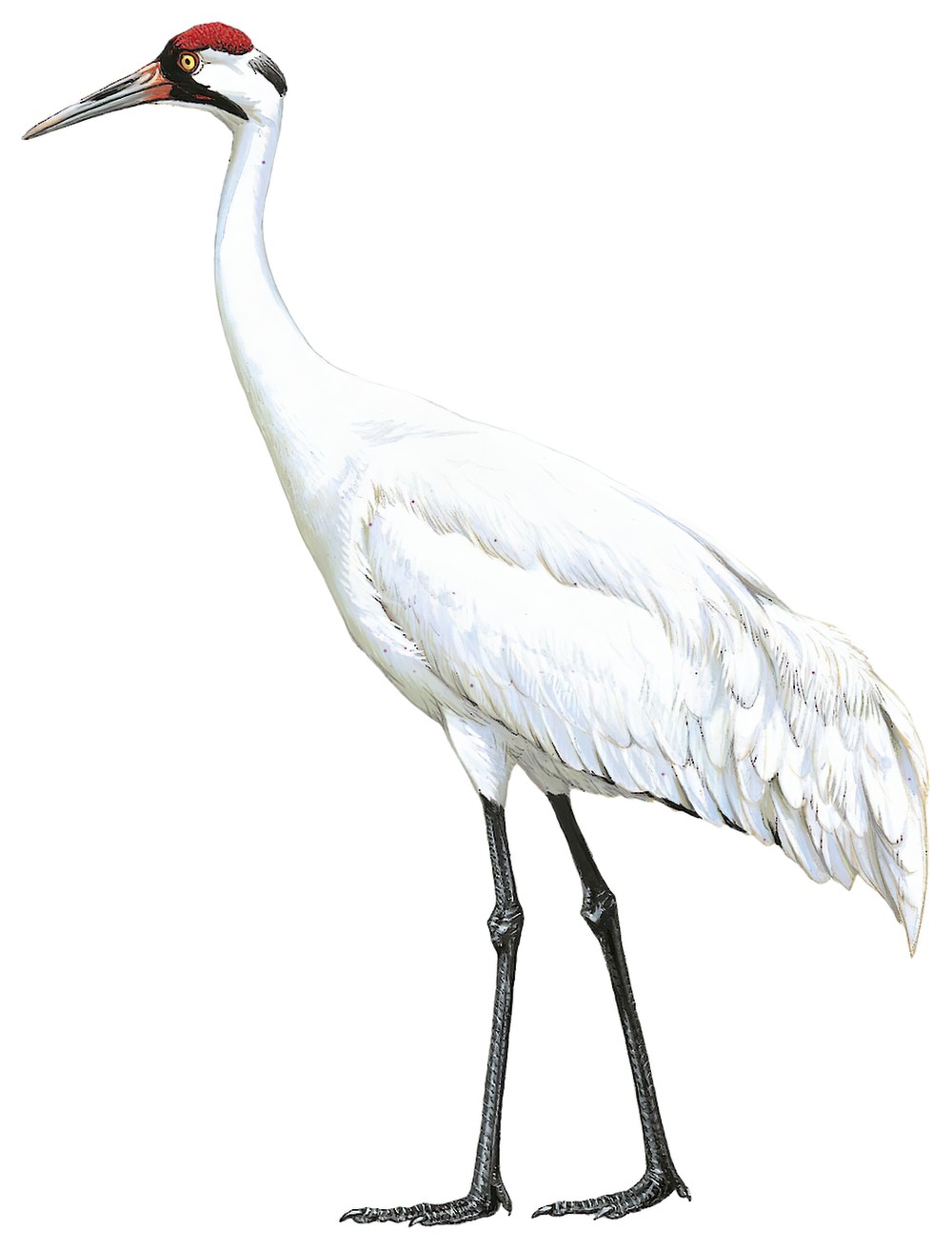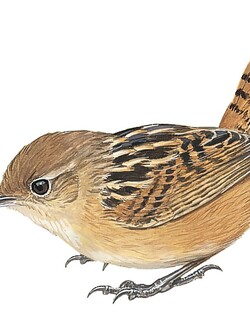Whooping Crane / Grus americana

Whooping Crane
SCI Name:
Protonym: Ardea americana Syst.Nat.ed.10 p.142
Taxonomy: Gruiformes / Gruidae / Grus
Taxonomy Code: whocra
Type Locality: North America = Hudson Bay, ex Edwards.
Author: Linnaeus
Publish Year: 1758
IUCN Status: Endangered
DEFINITIONS
GRUS
(Gruidae; Ϯ Common Crane G. grus) L. grus, gruis crane; "**6. LA GRUE. ... GRUS" (Brisson 1760): based on "Grus" of Gessner 1555, and many other authors, and Ardea Grus Linnaeus, 1758; "GRUS CREPITANS SEU PSOPHIA LINNÆI. AVES ab Ill. LINNÆO sub Ardearum nomine recensitæ, constantibus & evidentissimis characteribus in tria genera, ab antiquioribus jam olim Ornitholologis judiciose adoptata, distingui possunt; Ardearum nempe, Ciconiarum atque Gruum. ... GRUES denique, inter Ardeas & Otides quasi mediæ & ambiguæ, conveniunt inter se rostro cranium vix excedente, basi, ubi nares, canaliculato, extremitate convexiusculo, linguaque gallinacea; Pedes habent proceros, digitos mediocres, posticum parvum & a terra remotiusculum, plicam inter anticorum tantum externum & medium, unguesque tandem mediocres, acutos. Capite gaudent plumosiore, quam Ardeæ, atque sæpe vario ornatu insigni; femora quoque minus alte denudata sistunt." (Pallas 1766); “The earliest use of Grus as a genus is undoubtedly that of Pallas ... A reference to this work will show that it was proposed for the bird known as Psophia crepitans Linn., and therefore Grus as a genus can only be regarded as a synonym of Psophia proposed by Linnaeus, also in 1766. Gray recognised this fact in 1841, and proposed Megalornis for the Common Crane, Ardea grus Linn. As, however, the generic name Grus has always been associated with the Common Crane since the time of Bechstein in 1793, and the use of Megalornis has only recently been brought to the notice of present day ornithologists (cf. Iredale, Nov. Zool. xvii.1910, p. 502), the Committee have decided to retain Grus as a “nomen conservandum” ” (BOU 1915) (In fact, G. Gray 1841, considered Grus Moehring, 1752, to be preoccupied by Grus Linnaeus, 1735 (= Balearica Brisson, 1760), both pre-Linnaean); "Grus Pallas, Misc. Zool., 1766, p. 66. Type, by tautonymy, Ardea grus Linné.1 ... 1 The International Commission on Zoological Nomenclature has ruled (opinion no. 103) that Grus Pallas, refers to all the species placed in the section Grues of the 10th ed. of Linné's Syst. Nat., not to Psophia crepitans Linné alone. The determination of Ardea grus as the genotype of Grus Pallas, precludes the further use of the name Megalornis G. R. Gray (List Gen. Bds., ed. 2, 1841, p. 85)." (Peters 1934, II, 150); "GRUS Brisson, 1760 F — "Grus" Brisson; type by tautonymy = Ardea grus Linnaeus, 1758 5 ... 5 For change from Pallas to Brisson see Direction 55 (I.C.Z.N., 1956)" (Dickinson and Remsen (eds.), H. & M. Complete Checklist, 4th ed., 2013, 1 (Non-passerines), p. 165)."
Synon. Limnogeranus, Mathewsena, Mathewsia, Megalornis, Pseudogeranus.
grus
L. grus, gruis crane; "76. ARDEA. ... Grus. 4. A. vertice nudo papilloso, fronte remigibus occipiteque nigris, corpore cinereo. Ardea vertice papilloso. Fn. svec. 131. Grus. Bell. av. 41. 6. Gesn. av. 529. Aldr. orn. l. 20. c. 5. Jonst. av. 166. t. 44. Will. orn. 200. t. 48. Raj. av. 95. Mars. danub. 5. p. 6. t. 1. Alb. av. 2. p. 60. t. 65. Habitat in Europæ, Africæ campis subhumidis. Trans pontum fugat & terris immittit apricis. Virg." (Linnaeus 1758) (Grus).
americ / americana / americanum / americanus
Mod. L. Americanus American, of the Americas. Received opinion states that America was named after Amerigo Vespucci (d. 1512), a Florentine merchant who promoted and sailed on several voyages to the New World 1500-1502. The name was first used, of South America, by the cartographer Martin Waldseemüller in 1507. More recently Lloyd & Mitchinson 2009, have repeated the argument that the Americas were named after Richard Ameryk (d. 1503), a Welsh merchant and High Sheriff of Bristol who invested in John Cabot’s voyages of discovery 1497-1498. Coues 1882, refers to a Nicaraguan Indian name Americ for a local range of mountains, forgetting, however, that Nicaragua was not subdued by the conquistadores until 1522.
● North America; ex “Black-cheeked Eagle” of Latham 1781, and Pennant 1787 (?syn. Aquila chrysaetos).
● America (= eastern USA); ex Anas clangula of A. Wilson, 1814, and “Golden-Eye Duck” of Audubon 1836 (subsp. Bucephala clangula).
● Cayenne; ex “Martin-pescheur du Brésil” of Brisson 1760, “Martin-pecheur vert et blanc de Cayenne” of d’Aubenton 1765-1781, pl. 591, and “White and green Kingsfisher” of Latham 1782 (Chloroceryle).
● "52. CUCULUS. ... americanus. 7. C. cauda cuneiformi, corpore supra cinereo: subtus albo, maxilla inferiore lutea. Cuculus carolinianus. Catesb. car. 9. t. 9. Habitat in Carolina." (Linnaeus 1758) (Coccyzus). This name is the eighth toponym in avian nomenclature.
● North America; ex “Cinereous Coot” of Latham 1785 (Fulica).
● "76. ARDEA. ... americana. 5. A. vertice temporibusque nudis papillosis, fronte nucha remigibusque primariis nigris, corpore albo. Grus americana alba. Catesb. carol. I. p. 75. t. 75. Edw. av. 132. t. 132. Habitat in America septentrionali. Caput subtus ad maxillam inferiorem rubrum est." (Linnaeus 1758) (Grus).
● Erroneous TL. North America (?= Cayenne); ex “Black-chested Eagle” of Pennant 1766 (?syn. Harpia harpyja).
● Cayenne; ex “Aigle d’Amérique” of d’Aubenton 1765-1781, pl. 417 (Ibycter).
● Louisiana; ex “Pie-grièche de la Louisiane” of d’Aubenton 1765-1781, pl. 397 (syn. Lanius ludovicianus).
● Cayenne; ex “Merula indica pectore cinnabarino” or “Jacapu” of Marcgrave 1648, “Red-breasted Indian Blackbird” of Willughby 1676, “Troupiale de Cayenne” of d’Aubenton 1765-1781, pl. 236, fig. 2, and de Buffon 1770-1783, “Mocking bird of Guiana” of Bancroft 1769, and “Red-breasted Oriole” of Latham 1782 (syn. Leistes militaris).
● Paraguay; ex “Tordo degollado tercero” of de Azara 1802-1805, no. 70 (syn. Leistes superciliaris).
● Louisiana and New York; ex “Canard Jensen de la Louisiane” of de Buffon 1770-1783, and “American Wigeon” of Pennant 1785, and Latham 1785 (Mareca).
● North America; ex Mergus merganser A. Wilson, 1814 (subsp. Mergus merganser).
● Erroneous inferred TL. America (= Île de France (= Mauritius) = Philippines); ex “Guespier de l’Île de France” and “Petit Guespier des Philippines” of Brisson 1760 (Merops).
● "74. MYCTERIA. ... americana. 1. MYCTERIA. Jabiru-guacu. Marcgr. bras. 201. Pis. bras. 87. Raj. av. 96. Will. orn. 202. t. 47. f. 2. 4. Habitat in America calidiore. Magnitudo Ciconiæ, alba, remigibus rectricibusque nigro-purpurascentibus. Conf. Grew. mus. t. 5. f. 1." (Linnaeus 1758) (Mycteria).
● Louisiana; ex “Gallinula martinica” of Ord 1825 (syn. Porphyrula martinica).
● North America; ex “Avosetta” of Dampier 1697, and “American Avoset” of Pennant 1785, and Latham 1785 (Recurvirostra).
● "86. STRUTHIO. ... americanus. 3. S. digito postico rotundato mutico. Struthio Camelus americanus. Raj. av. 36. Nhanduguacu brasiliensibus. Marcgr. bras. 190. Pis. bras. 84. Habitat in America australi." (Linnaeus 1758) (Rhea).
● South Carolina; ex “Parus Fringillago. Finch-Creeper” of Catesby 1731 (Setophaga).
● America (TL erroneously given as Europe); ex “Yellow-backed Warbler” of Latham 1783 (syn. Setophaga americana).
● "102. CAPRIMULGUS. ... americanus. 2. C. narium tubulis eminentibus. Caprimulgus s. Noctua sylvatica jamaicensis. Sloan. jam. 2. p. 298. t. 255. f. 1. Raj. av. 180. Hirundo major subfusca miscella, macula alba sphærica in utraque ala. Brown. jam. 467. Habitat in America calidiore." (Linnaeus 1758). This is the last avian name in the epochal tenth edition of Linnaeus (‡Siphonorhis).
● New York; ex “Black-throated Bunting” of Pennant 1785 (Spiza).
● Some part of America (= Cayenne); ex “Black-breasted Grosbeak” of Latham 1783 (Sporophila).
● Virginia (= Pennsylvania); ex “Urogallus minor. Cocq de bois d’Amérique”of Catesby 1731, and “Attagen americana” of Brisson 1760 (syn. Tympanuchus cupido).
● Río de La Plata; ex “Hirondelle à croupion roux et queue carrée” of de Buffon 1770-1783, and “Rufous-rumped Swallow” of Latham 1782 (unident.).
UPPERCASE: current genus
Uppercase first letter: generic synonym
● and ● See: generic homonyms
lowercase: species and subspecies
●: early names, variants, mispellings
‡: extinct
†: type species
Gr.: ancient Greek
L.: Latin
<: derived from
syn: synonym of
/: separates historical and modern geographic names
ex: based on
TL: type locality
OD: original diagnosis (genus) or original description (species)












